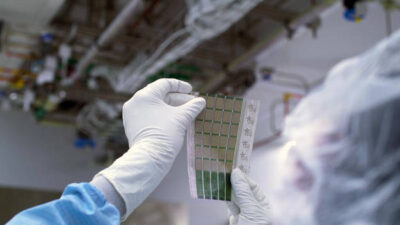Professors Bernard Kippelen and Seth Marder of the Center for Organic Photonics and Electronics (COPE) at Georgia Tech are developing light-emitting diodes (LEDs) using organic elements that could replace or augment digital displays used in cell phones and TVs while also offering new methods to light a variety of objects.

Professors Bernard Kippelen and Seth Marder of the Center for Organic Photonics and Electronics (COPE) at Georgia Tech are developing light-emitting diodes (LEDs) using organic elements—principally carbon, hydrogen, oxygen, and nitrogen—that abound in Earth’s biosphere.
The resulting organic LEDs (OLEDs) are designed to be flexible and shatterproof and could replace or augment digital displays used in cell phones and TVs while also offering new ways to light everything from a tiny medical probe to entire interior surfaces.
Most digital devices today use displays made with indium tin oxide that is deposited onto a glass substrate. Such displays are generally inflexible and brittle. Moreover, the relatively high price of indium, a rare earth element, adds significantly to manufacturing costs.
By contrast, the COPE team uses low-cost, Earth-abundant organic materials to fabricate a display surface that can produce plentiful light from a small amount of electric current. The researchers deposit exceedingly thin metal foils and films of organic molecules on a very thin plastic substrate. The total device has a thickness of about 100 nm. This is much thinner than conventional displays, which can be up to a millimeter thick.
COPE’s current device fabrication method involves evaporating organic molecules using extreme heat and then depositing them onto a plastic substrate. In the future, however, OLED light-emitting surfaces could be manufactured using roll-to-roll printing processes. This approach may yield large display surfaces capable of showing video or providing customizable lighting sources covering entire walls or ceilings.
Because they’re flexible, OLEDs can also conform to curved surfaces. That capability would allow them to serve as light-emitting surfaces in tight places such as medical catheters or to provide illumination for optics and protective gear used during surgery.
COPE’s approach also promises environmental benefits. The organic materials used by the light-emitting foil and its substrate can be designed to be biodegradable. Unlike conventional displays, which may contain elements that are toxic and costly to recycle, simply being dissolved in water at room temperature could recycle an OLED display.
– Rick Robinson, Georgia Institute of Technology. Edited by Chris Vavra, production editor, CFE Media, Control Engineering, [email protected].
Key concepts
- Researchers are developing LEDs using organic elements found in Earth’s biosphere.
- The resulting materials are flexible and can be used for many existing technologies as well as future developments.
- The research is also designed to be beneficial to the environment since the technology isn’t toxic and costly to recycle.
Consider this
What specific technologies could benefit from OLED technology that wasn’t mentioned in the article?
ONLINE extra
See additional stories about lighting and LED research below.



